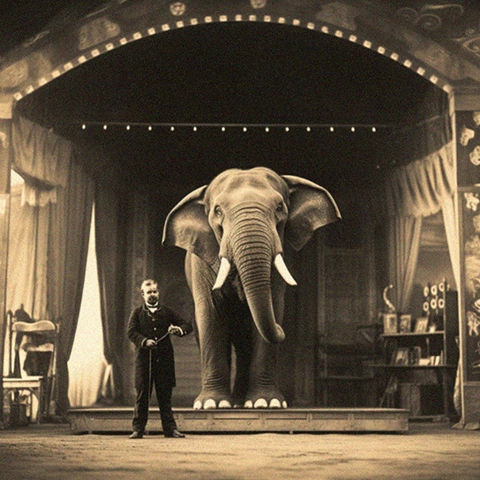In the vibrant tapestry of early 20th-century stage magic, few tales are as beguiling and unresolved as that of Augustus DeLamere, a magician whose name became inseparable from the enigmatic disappearance of an elephant known as Mr. E. Lephant. It was an era marked by showmen who defied belief with their sleight of hand and grand illusions, and among them, DeLamere aspired to stand out, to perform a feat so audacious it would secure his legacy in the annals of magic history.
Augustus DeLamere was not the most famous of his contemporaries, but he was certainly one of the most ambitious. It was in the heart of New York City where he promised a spectacle to outshine his peers. The audience, a blend of the city’s elite and curious onlookers, filled the opulent theater, their whispers a prelude to the astonishment DeLamere promised them.
The lights dimmed, and the murmurs hushed as DeLamere took the stage, his presence commanding and his eyes alight with secretive mirth. But the true star of the evening was yet to make an entrance. With a grandiose gesture, DeLamere introduced Mr. E. Lephant, an elephant of such magnificent size and gentle demeanor that the crowd gasped in delight and disbelief. The beast’s name, a clever play on the word ‘elephant,’ suggested that what they were about to witness would be nothing short of magical.
DeLamere’s act began with the usual array of illusions, each a mere precursor to the evening’s main event. Finally, the moment arrived. DeLamere led Mr. E. Lephant to a colossal structure in the center of the stage, veiled by curtains emblazoned with mystical sigils and arcane glyphs. The magician claimed they were symbols of ancient power, capable of making the very large become very small, or even disappear entirely.
With a showman’s flourish, DeLamere enclosed the gentle giant within the structure, his wand raised in dramatic anticipation. A moment later, the curtains were drawn, and a palpable suspense filled the room. Then, as if by a wave of some otherworldly force, the curtains collapsed to reveal a void where Mr. E. Lephant once stood.
The audience’s applause was thunderous, a testament to their belief in DeLamere’s powers. But as the evening progressed, it became evident that something was amiss. Mr. E. Lephant did not reappear as planned. The show concluded not with a final bow but with a confused magician frantically improvising to cover the mishap.
The following days were filled with frantic searches, public inquiries, and escalating theories ranging from a tragic accident to an elaborate hoax. DeLamere’s career faltered under the weight of speculation and his reputation soured. People had come to see an illusion, but the line between spectacle and reality had been blurred beyond recognition.
The story of Augustus DeLamere and Mr. E. Lephant morphed into a legend, a magic act that had ventured too far into the unknown. DeLamere himself retreated from the public eye, his name forever entwined with the mysterious disappearance that he could neither explain nor replicate.
To this day, the fate of Mr. E. Lephant is a mystery wrapped in the shroud of magic and myth. Was it a trick gone wrong, or was there something more to the elephant’s vanishing act? The truth vanished along with the great beast, leaving behind a legacy that is as much a tale of caution as it is a narrative of the eternal human desire to believe in the unbelievable. Augustus DeLamere’s name remains etched in the chronicles of magic, not for the illusions he conjured, but for the one he could not undo.

